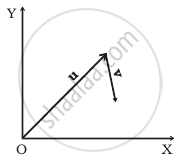Advertisements
Advertisements
प्रश्न
Find a vector which is parallel to `vec"v" = hat"i" - 2hat"j"` and has a magnitude 10.
उत्तर १
Let the vector be `vec"w" = "w"_"x" hat"i" + "w"_"y"hat"j"`
`|vec"w"| = sqrt("w"_"x"^2 + "w"_"y"^2) = 10` ....(Given)
∴ `"w"_"x"^2 + "w"_"y"^2 = 100` ...(i)
Also, `vec"v"*vec"w"` = vw ....(∵ `|vec"v"| and |vec"w"|`are parallel vectors)
`=> (hat"i" - 2hat"j")*("w"_"x" hat"i" + "w"_"y"hat"j") = sqrt((1)^2 + (-2)^2) xx 10` ....`(∵ |vec"v"| = sqrt((1)^2 + (-2)^2))`
∴ `"w"_"x" - 2"w"_"y" = 10sqrt5` ...(ii)
Substituting for wx in (i) using equation (ii),
`(10sqrt5 + 2"w"_"y")^2 + "w"_"y"^2 = 100`
∴ `500 + 40sqrt5 "w"_"y" + 4"w"_"y"^2 - 100 = 0`
∴ `5"w"_"y"^2 + 40sqrt5"w"_"y" + 400 = 0`
∴ `"w"_"y"^2 + 8sqrt5"w"_"y" + 80 = 0`
Using factorisation formula,
x = `(-"b" +- sqrt("b"^2 - 4"ac"))/"2a"`
`"w"_"y" = (-8sqrt5+-sqrt((8sqrt5)^2 - 4 xx 1 xx 80))/(2xx1)`
`= "w"_"y" = (-8sqrt5 +- 0)/2 = - 4sqrt5 = (-20)/sqrt5`
Using equation (ii),
`"w"_"x" = 10sqrt5 + 2((-20)/sqrt5)`
`= 10sqrt5 - 40/sqrt5`
`= ((10sqrt5 xx sqrt5) - 40)/sqrt5`
`= (50 - 40)/sqrt5`
`= 10/sqrt5`
∴ `vec"w" = "w"_"x"hat"i" + "w"_"y"hat"j" = 10/sqrt5 hat"i" - 20/sqrt5hat"j"`
उत्तर २
When two vectors are parallel, one vector is scalar multiple of another,
i.e., if `vec"v" and vec"w"` are parallel then, `vec"w" = "n"vec"v"` where, n is scalar.
This means, `vec"w" = "nv"_"x" hat"i" + "nv"_"y"hat"j"`
`= "n"hat"i" - 2"n"hat"j"` .....`(because "v"_"x" = l, "v"_"y" = 2)`
∴ `|vec"w"| = sqrt(("n")^2 + (-2"n")^2) = sqrt5"n"`
Given: `|vec"w"| = 10`
∴ n = `10/sqrt5 = 2sqrt5`
∴ `vec"w" = 2sqrt5hat"i" - 2(2sqrt5)hat"j"`
`= 2sqrt5hat"i" - 4sqrt5 hat"j"`
`= (2sqrt5 xx sqrt5)/sqrt5 hat"i" - (4sqrt5 xx sqrt5)/sqrt5 hat"j"`
∴ `vec"w" = 10/sqrt5 hat"i" - 20/sqrt5hat"j"`
APPEARS IN
संबंधित प्रश्न
`hati "and" hatj` are unit vectors along x- and y-axis respectively. What is the magnitude and direction of the vectors `hati+hatj` and `hati-hatj` ? What are the components of a vector `A = 2hati + 3hatj` along the directions of `hati + hatj` and `hati - hatj` ? [You may use graphical method]
Answer the following question.
Show that `vec"a" = (hat"i" - hat"j")/sqrt2` is a unit vector.
Answer the following question.
If `vec"v"_1 = 3hat"i" + 4hat"j" + hat"k" and vec"v"_2 = hat"i" - hat"j" - hat"k"`, determine the magnitude of `vec"v"_1 + vec"v"_2`.
For `vec"v"_1 = 2hat"i" - 3hat"j" and vec"v"_2 = -6hat"i" + 5hat"j"`, determine the magnitude and direction of `vec"v"_1 + vec"v"_2`.
Answer the following question.
Show that vectors `vec"a" = 2hat"i" + 5hat"j" - 6hat"k" and vec"b" = hat"i" + 5/2 hat"j" - 3hat"k"` are parallel.
Determine `veca xx vecb`, given `veca = 2hati + 3hatj and vecb = 3hati + 5hatj`.
Walking of a person on the road is an example of
Figure shows the orientation of two vectors u and v in the XY plane.

If `u = ahati + bhatj` and `v = phati + qhatj`
which of the following is correct?
The component of a vector r along X-axis will have maximum value if ______.
